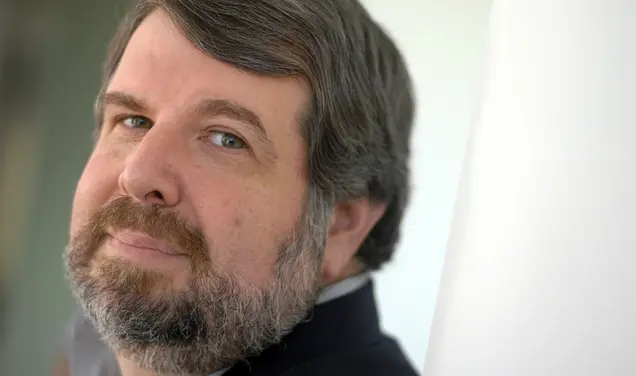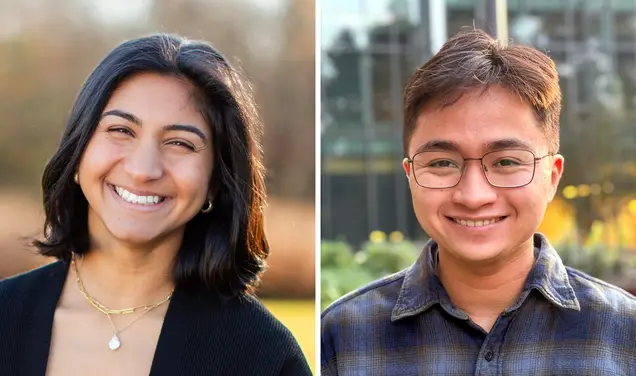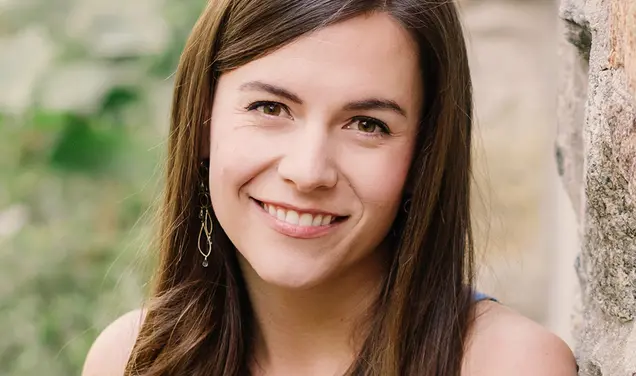"Creative Dislocations," by John Fish '55
John Fish ’55’s final sermon, delivered April 27, 2014
I think it is appropriate that I preach my final sermon on Earth Day. The text for this sermon is Genesis 3:19. “In the sweat of your face you shall eat bread ’til you return to the ground. For out of it you were taken, you are dust and to dust you shall return.”
On this Earth Day, let it be clear, we are part of the earth. Out of it we are taken and into it we shall return. I am preparing to return to dust. Now I don’t want this, my final sermon, to be a downer. I want to affirm life on this Earth Day. Only by embracing death, by honoring death can we affirm life. French philosopher of the Renaissance period, Michel de Montaigne, exclaimed, “In learning how to die we also learn how to live.” Earlier the Roman thinker Seneca had the same sentiment, “He will live badly who does not know how to die well.”
How do we learn how to die well? At Montgomery Place, where I am living, the chaplain Julianne Buenting and I led a series of discussions on death and dying. It was delightfully entitled “Coffee, Tea, and Death.” We thought maybe 8 or 10 people would be interested. Over 40 showed up. The discussion was wide-ranging from overcoming the taboo about talking about death, to management of pain near the end, to the desire for the opportunity for assisted suicide, to making the most of our remaining time, to having our end-of-life decisions honored by our caregivers. There were countless stories of how their children or their closest friends simply did not want to talk about death. They would say things like, “Don’t be silly Mom. You are going to live for years.” And then move onto the weather or the missing Indonesian plane or sports. Mom’s very real concern was dismissed as something we should not even discuss.
Why don’t we want to talk about it? Part of our discomfort may be that for many of us death has been removed from our experience. You could call it the medicalization of death. There was a time when dying and death was handled by family, friends and neighbors. We helped each other die. Now death is more likely in the hands of technical experts in the medical system. One poll indicated that 70 percent of us would like to die at home. The truth is that out of about 6,500 people who die every day in the U.S. about 18 percent, or only 1,200, die at home surround by friends and family; 82 percent die in hospitals. The vast majority are plugged into life-support systems or treated in sterile hospital settings by professionals whose only goal is to keep them alive.
Our discussion at Montgomery Place was well-received. Many participants expressed real appreciation that we were able to talk about death because they had so many questions and no one with whom to talk about this. I googled “Good Death” and up comes a variety of lists of principles for a good death. Many of them stress having a measure of control over the final dying process, knowing what to expect, being able to control the pain, being able to issue advance directives that insure that your wishes are respected, having access to spiritual and emotional support, having time to say goodbye, having control over who is present and who shares the end. The common theme is death with dignity, having a measure of control at the end. We all go through it. We only die once so we might as well try to do it well.
Now back to my experience in life, primarily as a teacher. The basic thesis is this: What we see depends on where we are located. By location I mean not only our geographic location but our race, gender, social class, our family, our schooling, our upbringing. Our location is who we are and this determines to a large extent what we think and what we do. If we do not change our location then we are simply continuing along a path that is laid out for us, that is prescribed for us. We never grow.
Bob Brown, one of my teachers at Union Theological Seminary, wrote a book about significant changes in his life called “Creative Dislocation.” I am recalling some of the times in my own life when new experiences or new locations led me to think and see differently. As a teenager I spent a summer in London working in a boy club in one of the most distressed communities, Bethnal Green. It was the summer of 1950 and London was still recovering from World War II. It was all new for me and I began for the first time to see the world and my place in it through different lenses. I began to see differently and to think differently. I began to raise serious questions about the poverty, about those on the margins, and about the role of government to address social issues poverty. I shared for a few days my room with a former German Luftwaffe pilot who had a few years earlier bombed London and was returning as part of his own healing. He was experiencing London from a different location. He certainly had different lenses. This was a transforming experience for him. This summer in London was also a transforming experience for me, but for different reasons. I saw the world and my place in it through different lenses. A creative dislocation.
More than a decade later, in the sixties, I spent considerable time in Woodlawn during my graduate program at the University of Chicago. There were service agencies that did not serve and representatives that did not represent. I became suspicious of the intentions of the University and various city agencies. They were not necessarily friends of Woodlawn. I had new lenses.
Then a decade later, in the Urban Studies Program, and later in the Princeton Project, I placed students in organizations in North Lawndale and other distressed neighborhoods in Chicago. The idea was to provide for the student a creative dislocation. Many of them had a life-changing experience during their semester or year in a new location. They had an experience similar to what I had in London and Woodlawn. For some it changed the trajectory of their lives.
In the ’80s I went to Nicaragua with Witness for Peace. With over 100 North Americans, including my son Dan, and Liza Hendricks, the Assistant Pastor of this church, I was on the border with Honduras where the U.S. was (illegally, I might add) providing weapons for the Contras to attack Nicaragua and hopefully overthrow the Sandinista government. We visited a hospital where one of the patients, recovering from wounds inflicted by US weapons, asked a small group of us around his bed a simple question, “Why are you doing this to us?” I did not have a good answer.
A few years later I went to Guatemala and El Salvador with various delegations and began to see the United States differently, not as a well-meaning supportive big brother but more as a big bully who wanted to control smaller countries to the south. In all of these experiences I began to see through Third World eyes.
The most meaningful experiences in my life have come from creative dislocations.
Now I am in a new location. I am approaching the end of life. This is a new perspective for me. Again, new lenses. Among other things, it has caused me to reflect more on my own faith journey. I am sure I have reflected upon this before but this is near the end and I will before too long be returning to the earth.
I think of the Baptist Church in Erie, Pa., where as a teenager I was baptized and joined the church. The pastor I remember most was Roger Sharpe clearly in the social gospel tradition. We are called to follow Jesus. Jesus is the example of goodness and love. I didn’t go to church very often but that message resonated with me. I was moved by it. Then I went to London after my 11th grade year. There I came under the influence of two men, one affectionately known as Tubby Clayton. After WW II, Tubby founded an organization of former British soldiers around a gospel of Fellowship and Service. It was this organization that came up with the idea of having American young people come to London for a summer of service. The other person that impacted me that summer was Sir George McCloud, founder of the Iona community in Scotland, a community also based on fellowship and service. Members of the Iona community gathered in the summer to participate in the rebuilding of the Iona Abbey. St. Columba landed on Iona in the Western Hebrides in the 600s bringing Christianity to Scotland. But I digress. Both groups required a serious discipline for their members. I joined neither group but was fascinated by both.
As I entered college — itself a creative dislocation for many young people — I began to think that the call to follow Jesus and do good was nice but it failed to account for what was happening in the world, the horrific trench warfare in WWI, the depression, WWII, the holocaust, and Hiroshima. In Princeton I began to read the religious thinker Reinhold Niebuhr. Niebuhr helped me see a far more complicated world in which doing good is not so easy. For Niebuhr good and evil are intermingled. Niebuhr gave me new lenses and I began to take Christianity more seriously, not simply as a call to do good, but as a way of understanding the world and my role in it. There was no religious conversion. The more I read and thought about it, Christianity began to make sense as a way of looking at reality. If anything, I had an intellectual conversion. I wrote my senior thesis on Niebuhr and then went to Union Theological Seminary to study under him. I began to see that the love Jesus calls us to is not an easy possibility in this world. Justice, Niebuhr would argue, is the closest we can come to love in a fallen world. Let me repeat that: Justice is the closest we can come to love in a fallen world.
Over the years since then through many experiences I began to link the passion of the social gospel of my youth with the insights of Niebuhr about social justice. Jesus is the revelation of God. In Jesus we see God’s love. In Jesus we see God’s passion for justice. And in Jesus we find God’s forgiveness for our feeble efforts. Jesus is a metaphor for God. It comes down to fellowship and service, love and justice — and also forgiveness for our failure to live up to what Jesus calls us to do and be.
What I couldn’t appreciate was intricate theological doctrines that accumulated over the centuries. Except as historical expressions, the early creeds and the various doctrines didn’t make much sense. Take for example the traditional view of the atonement whereby Jesus in his death wipes out all our sins. And that if you confess Jesus as your savior he will take away your sins and you will go to heaven and be with him forever. All of that otherworldly salvation talk just doesn’t speak to me. Religion, in its various forms, is a human creation. So I am left with fellowship and service and love and justice and forgiveness. As I near the end, I think that is enough.
And one more thing. I was reminded of it in Julian’s sermon on Easter. Dance. Or, I would say, have a party. Yesterday, 80 of us had a party at Montgomery Place. These were students and colleagues from the Urban Studies program where I taught for 30 years. They came to have a party and also to say goodbye. I was reminded yesterday of how important it is to have a party. So love, justice, forgiveness, and have a party.










No responses yet